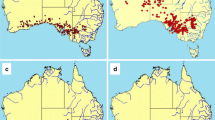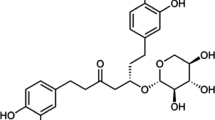Abstract
Seasonal changes in the production of primary nutrients (soluble carbohydrates) and secondary metabolites (terpenes, monomeric phenolics, and tannins) in the current needle tissue of Douglas fir were investigated. All four classes of compounds showed significant seasonal changes in concentration during foliage development. Most terpenes increased significantly in concentration from June 11 to August 3, and then showed declining concentrations to September 20. The most dramatic and significant seasonal increases occurred inα-pinene, camphene, and bornyl acetate concentrations. The monomeric phenolics chlorogenic acid, taxifolin glucoside, quercetin galactoside, and those unknown phenolics showed an overall trend of declining in concentration from June 11 through September 20. However, considerable variation between sampling dates in the concentration of these phenolics was noted. Tannin concentration decreased significantly from June 11 to July 9, and then increased in concentration to the September 20 sampling date. Fructose, galactose, glucose, and sucrose tended to decrease from June 11 to September 20. However, significant variation between sampling dates was evident in these compounds as well. Galactose was the major compound in the soluble carbohydrate fraction, amounting to almost 80% of the total concentration throughout the growing season. These data suggest that if phenolics and tannins function as defenses, they would only affect second- and possibly third-instar budworm larvae during the time that these instars mine the buds. Camphene,α-pinene, and bornyl acetate increased in concentration throughout the growing season and may be effective deterrents to the budworm. Both bornyl acetate and camphene have been shown in field and laboratory studies to increase larval mortality and adversely affect budworm larval growth. Carbohydrates generally act as nutrients that enhance herbivore growth. However, in a previous study, galactose was found to cause reduced budworm larval growth and increased larval mortality.
Similar content being viewed by others
References
Carlson, C., Fellin, D., andSchmidt, W. 1983. The western spruce budworm in northern Rocky Mountain forests: A review of ecology, insecticidal treatments, and silvicultural practices,in The State of Knowledge and Research Needs. J. O'Loughlin and R. Pfister (eds.). Management of Second-growth Forests. Montana Forest and Conservation Experiment Station, Missoula, Montana.
Cates, R.G., andRedak, R. 1988. Variation in the terpene chemistry of Douglas-fir and its relationship to western spruce budworm success, pp. 317–344,in K. C. Spencer (ed.). Chemical Mediation of Coevolution. Pergamon Press, New York.
Cates, R.G., andZou, J. 1990. Douglas-fir (Pseudotsuga menziesii) in terpene chemistry and its role in budworm (Choristoneura occidentalis Freeman) Dynamics, pp. 169–182,in A. Watt, S. Leatyer, M. Hunter, and N. Kidd (eds.). Population Dynamics of Forest Insects. Intercept, London.
Cates, R.G., Redak, R., andHenderson, C. 1983. Patterns in defensive natural product chemistry: Douglas-fir and western spruce budworm interaction. American Chemical Society Symposium Series 208. American Chemical Society, Washington, D.C. pp. 3–19.
Clancy, K.M., Wagner, M.R., andTinus, R.W. 1988. Variation in host foliage nutrient concentrations in relation to western spruce budworm herbivory.Can. J. Fors. Res. 18:530–539.
Denno, R.F., andMcClure, M.S. (ed). 1983. Variable Plants and Herbivores in Natural and Managed Systems. Academic Press, New York. 717 pp.
Gambliel, H., andCates, R.G. 1995. Terpene changes due to maturation and canopy level in Douglas-fir (Pseudotsuga menziesii) current year's growth.Biochem. Syst. Ecol. In press.
Lindroth, R.L., Scriber, J.L., andStephen, H. 1988, Chemical ecology of the tiger swallowtail: Mediation of host use by phenolic glycosides.Ecology 69(3):814–822.
Martin, M.M., andMartin J.S. 1984. Surfactants: Their role in preventing the precipitation of proteins by tannins in insect guts.Oecologia 61:342–345.
Rosenthal, G.A., andJanzen, D.H. 1979. Herbivores: Their Interaction with Secondary Plant Metabolites. Academic Press, New York. 718 pp.
SAS Institute. 1985. SAS User's Guide: Statistics. SAS Institute, Inc. Cary, North Carolina.
Wagner, M.R., Clancy, K.M., andTinus, R.W. 1989. Maturational variation in needle essential oils fromPseudotsuga menziesii, Abies concolor andPicea engelmannii.Phytochemistry 28:765–770.
Wulf, W., andCates, R.G. 1987. Site and Stand Characteristics, pp. 89–115,in M. Brookes, R. Campbell, J. Colbert, R. Mitchell, and R. Stark (eds.). Western Spruce Budworm, Washington, D.C.
Zou, J., andCates, R.G. 1994. Role of Douglas fir (Pseudotsuga menziesii) carbohydrates in resistance to budworm (Choristoneura occidentalis).J. Chem. Ecol. 20:395–405.
Author information
Authors and Affiliations
Rights and permissions
About this article
Cite this article
Zou, J., Cates, R.G. Foliage constituents of douglas fir (Pseudotsuga menziesii (Mirb.) Franco (Pinaceae)): Their seasonal variation and potential role in douglas fir resistance and silviculture management. J Chem Ecol 21, 387–402 (1995). https://doi.org/10.1007/BF02036736
Received:
Accepted:
Issue Date:
DOI: https://doi.org/10.1007/BF02036736




